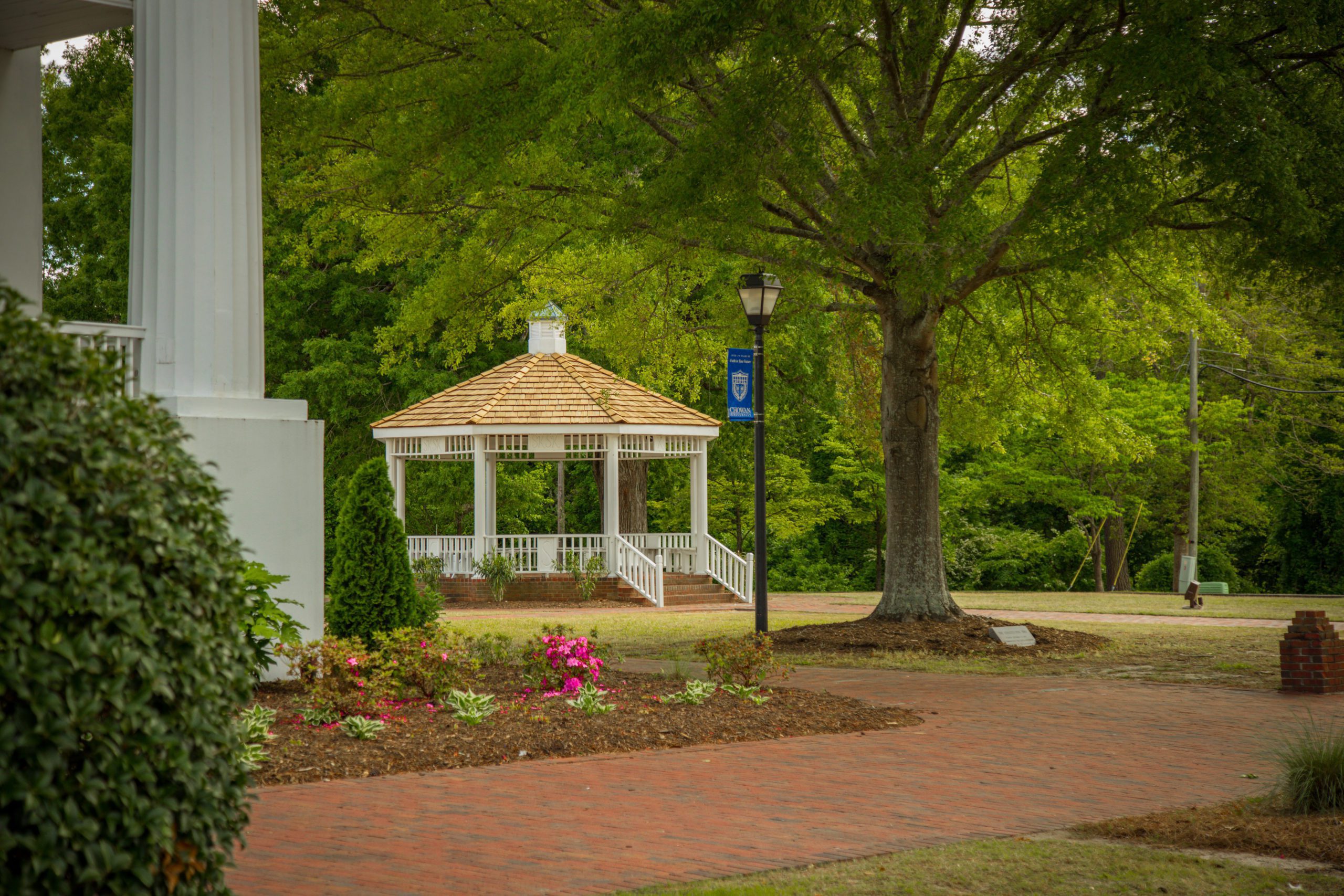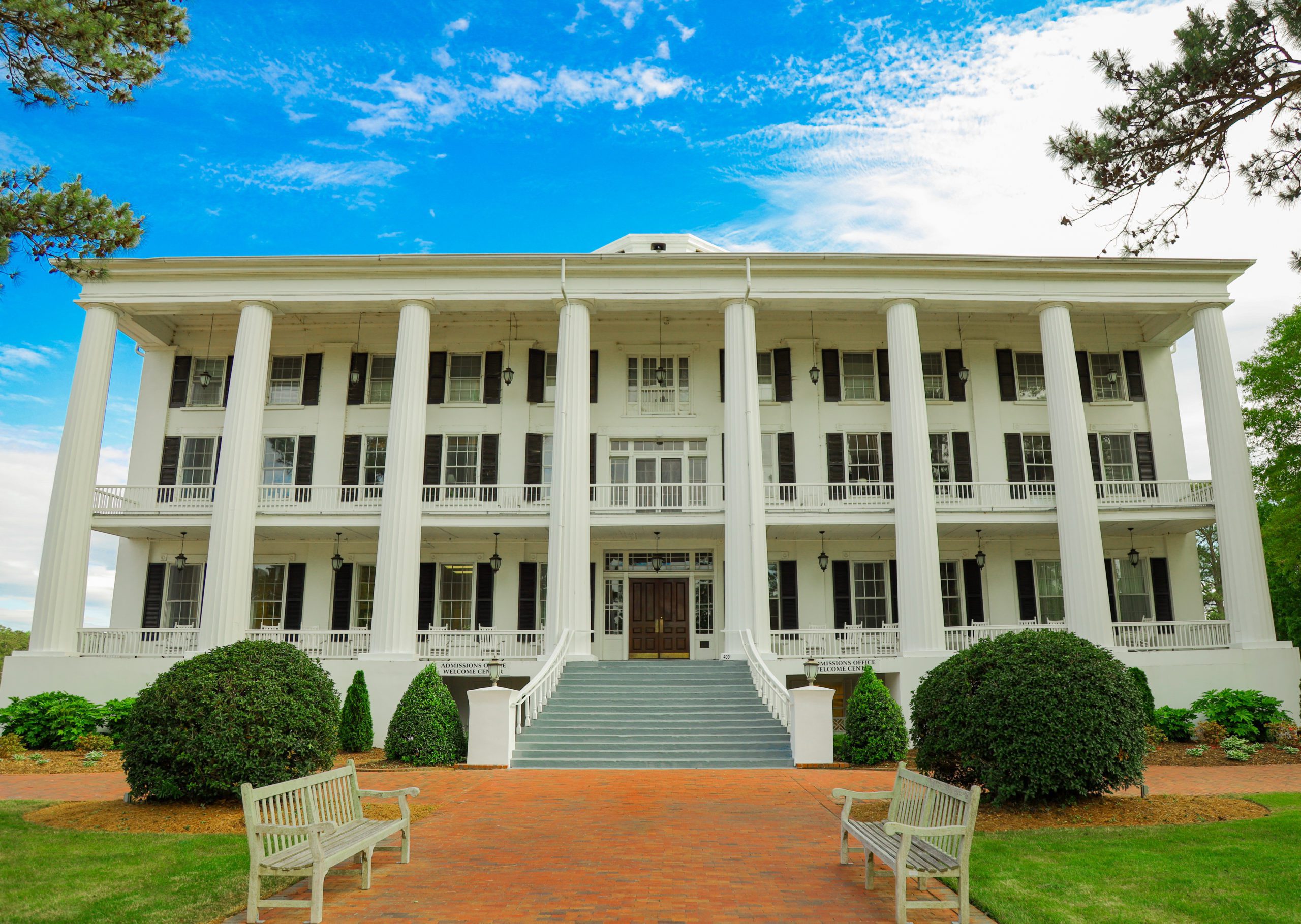Favored Traditions
Since the early 90s, the Alumni Walk has led up to the Gazebo which is located beside the historic Columns Building. The Alumni Walk is a special place that showcases graduates from each graduating class. When students graduate, they will get a brick with their name on it that will be a part of the Alumni Walk forever. When alumni come back to campus for a visit, their first stop is always the Alumni Walk to see their brick.
Located on the west side of the McDowell Columns Building in the gazebo is the Chowan University bell. The bell dates back to the 1800s. “The bell swung from two stone pillars until 1880, when it was placed in the Bell Tower, a favorite meeting place for students. The bell was used to change classes, call students to chapel, and celebrate athletic victories.” (Frank Stephenson, Chowan College, 2004)
The tradition of the bell today is to establish a sense of community that begins in the first year and lasts beyond the confines of the four-year university experience. Each September, following University Convocation, faculty in full regalia and first-year students proceed to the gazebo. With faculty lined up on both sides of the brick alumni walk leading to the gazebo, first-year students ring the bell to signify the beginning of their academic studies at Chowan.
The ringing of the bell is repeated again in April of each year. At the close of the Senior Banquet, the faculty and candidates for graduation recess from Thomas Dining Hall to the gazebo. With faculty lined up on both sides of the alumni walk once again, each candidate rings the bell one last time to signify the end of his or her academic studies at Chowan.

traditions
There are a number of traditions celebrated at Chowan University, some are once-a-year activities and others happen throughout the year. Each new academic year begins with a campus-wide worship service to dedicate the year to the Christian values of the university. Academic and Founders’ Day Convocation is a gathering of students, faculty, and staff to celebrate the beginning of the academic year and to reflect on Chowan’s past, present, and future. During the Fall Semester, the greatest tradition is Homecoming that includes a talent show, casino night, a semi-formal dance where the homecoming court is announced, a pep rally and bonfire, a parade and of course the annual Homecoming football game.
The story of the Chowan ghost known as the Brown Lady begins around the time of the Civil War. The woman who was a student at the time was engaged to a man who died in battle. When she received the news she either died of a broken heart or jumped to her death. In another version, the Brown Lady hails from an aristocratic farm family in Northampton County. During her sophomore year, she died of fever. Her taste in clothes ran to the earth tones, hence her name. She appears on campus, usually around Halloween, the date of her death, to test the spirit of loyalty of the students and to see if they have fallen away from the lofty ideals of Chowan. To remember her spirit, Chowan holds a Brown Lady Academic Bowl in her honor. The campus creative writing magazine is titled The Brown Lady.
Harvest Fest is an annual event hosted by the Student Government Association in collaboration with over twenty-five student clubs and organizations. Chowan students set up booths with activities, food, and candy for local children to enjoy. This safe alternative to trick-or-treating is free to the public. Not only does it offer children a safe, fun time, it also allows them to experience a small taste of college life and interact with current students.
As the university moves into the Spring Semester, attention turns increasingly toward graduation. Still, there are a number of traditional activities that take place prior to commencement. With the close of the semester, student life hosts a Hawks Fest Week. The annual Awards Day Convocation brings together students, faculty, and staff to reaffirm the major purpose of a university—to foster academic excellence—and to honor the achievements of the Chowan University students and faculty. A faculty member serves as the keynote speaker. On the last evening of classes, the Senior Banquet honors graduating students. Following the banquet, the candidates for graduation file in line to dawn the Alumni Walk to ring the bell to signify the end of their academic career at Chowan.
Another tradition at Chowan is the Senior Rock. Located just behind Penny Hall, the Senior Rock was requested by the Class of 2003. Officially, members of the senior class have the right to decorate it.
MCDOWELL
COLUMNS
Erected in 1851, is an imposing brick and concrete structure, with eight massive columns and broad veranda, characteristic of the old South. Now listed in the National Registry of Historic Places, the building was named McDowell Columns in 1968 to honor and memorialize Dr. Archibald McDowell, President, 1848-1849, 1862-81, and his daughter Dr. Eunice McDowell, class of 1876. In 2008 the exterior of the building was renovated with beautiful landscaping planted. Today the building contains most administrative offices (president, provost, business office, admissions and financial aid) and the campus bookstore. Turner Auditorium, which seats 650 is part of the complex and is the favored site of concerts and lectures. It is named in memory of the Reverend John Clyde Turner (1878-1974).

The blue and white
Students in the spring 2022 HON 114 – Honors First-Year Experience class researched, compiled, and created The Blue and White: Chowan’s Traditions Book.
